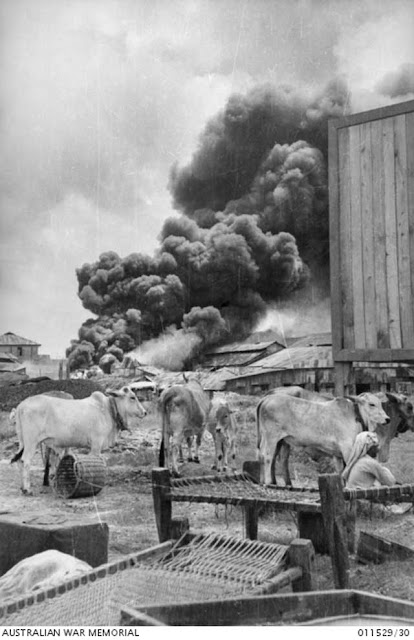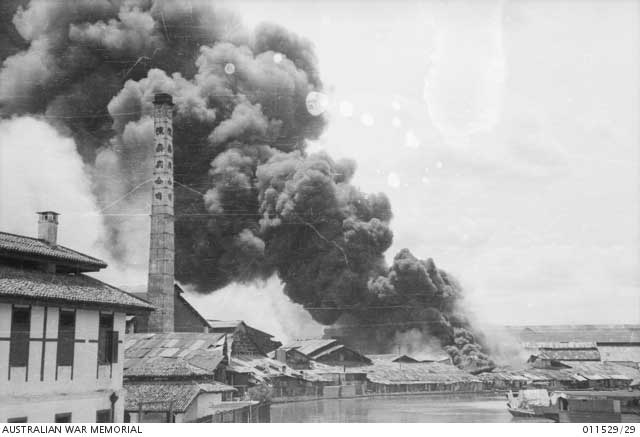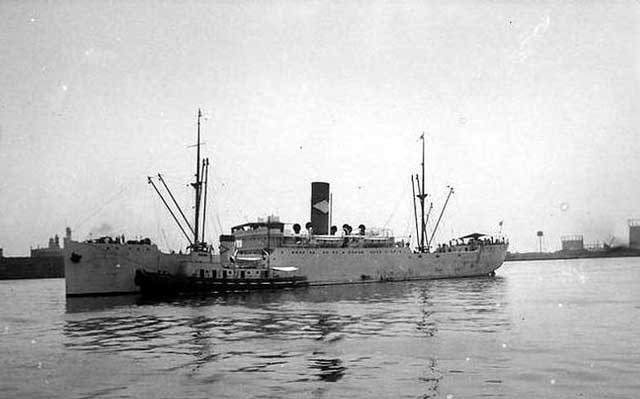Sunday 1 February 1942
 |
| An SBD-2 Dauntless dive bomber of either VB-6 or VS-6 on the carrier USS Enterprise (CV-6) prepares for takeoff during the 1 February 1942 Marshall Islands Raid (Barr, William, U.S. Navy National Museum of Naval Aviation photo No. 1996.253.599). |
Battle of the Pacific: The American Volunteer Group (AVG) in Burma is continuing its dramatic successes today, claiming 16 more Japanese planes on
1 February 1942, but the Americans now are beginning to flex their muscles closer to Japan, too. Today, the US Navy launches the Marshalls-Gilberts Raids. Vice Admiral William F. Halsey stages one of the first U.S. counterattacks against the Japanese by sending multiple waves of carrier planes against the Marshall Islands. Planes from
USS Enterprise focus on Wotje, Maloelap, and Kwajalein, while surface warships including heavy cruiser USS Chester shell the Taroa and Maloelap atolls (the bombardment force is under the command of Admiral Spruance). The Marshalls-Gilberts Raids are the first in a series of US Navy raids in early 1942, exemplified by the Doolittle Raid on Tokyo, that are of little strategic consequence but help morale throughout the Allied world.
 |
| Lt. Cdr. Bill Burch and Ensign Thomas Reeves flying SBD dive bombers from USS Yorktown over Makin, Gilbert Islands, 1 February 1942. |
At the same time, Rear Admiral Frank Jack Fletcher's Task Force 17 also raids Makin in the Gilbert Islands. USS Yorktown's SBDs hit Jaluit, Makin, and Mili, sinking a gunboat at Makin and sinking two Kawanishi H6K, "Mavis" flying boats at anchor. Two F4F Wildcats of Squadron 42 down a Mavis flying boat of the Yokohama Kokutai near TF-17. Task Force 11, commanded by Vice Admiral Wilson Brown Jr., remains nearby in reserve near Christmas Island. Today's operations are the first example in the Pacific Theater of Operations of the tremendous resources of the US Navy being brought to bear in an offensive capacity and provides a clear warning to the Japanese as to the hard fight ahead of them. Everything is not perfect, however, as the TBD-1 Devastator Torpedo bombers perform poorly, scoring only one hit in nine drops under good conditions. Due to the low expectations of this mission and the sheer joy of simply striking back, however, nothing is looked at with a critical eye.
 |
| A quad-1.1"/75 cal Mk 1 anti-aircraft gun mount on Enterprise (CV-6), in early 1942. |
The Japanese do not sit idly by during this attack. They launch five Mitsubishi G4M "Betty" land-based bombers and other planes and damage both the Enterprise (near-miss) and Chester (bombed). The Enterprise planes sink a transport and damage light cruiser HIJMS Katori (I-23), a minelayer, an auxiliary net-layer, an auxiliary submarine chaser, a submarine depot ship, an oiler, a tanker, and an army cargo ship. There are other American successes against Japanese shipping, too. Rear Admiral Sukeyoshi Yatsushiro (Commander Sixth Base Force) perishes in the attacks, the first Japanese flag officer to die in combat during World War I.
 |
| The Anniston (Alabama) Star correctly notes as its main headline "Siege of Singapore Gets Underway As Britain's Troops Quit Mainland." |
In Singapore, the Japanese mount fierce air raids against the isolated Commonwealth forces on the island. There are so many corpses that the Air Raid Precautions (ARP) unit has to collect them in special daily truck collections and dump them in mass graves. Civilian laborers who have been half-heartedly building fortification along the water's edge have disappeared. Because the British always have assumed that Singapore would be defended on the mainland, very little planning has been done for defending the island itself and the defenses are
ad hoc. Still, with the causeway cut, the Japanese will have to stage a major invasion to get across the Singapore Strait and claim final victory. The British do get good news when Convoy MS-1, composed of British freighters City of Manchester, Derrymore, and Gordon Peisander, and Norwegian freighter Pan Europe and tanks War Sirdar, arrive in Singapore escorted by light cruiser HMAS Hobart and destroyers Tenedos and Stronghold.
 |
| The 1 February 1942 Sunday News in New York shows the situation in Singapore, which has captured world attention. |
In the Philippines, the situation has developed into a status quo. The US Army has only four USAAF P-40s left, which are able to help in critical situations but helpless against the incessant air raids. The Allies continue trying to reduce Japanese pockets behind the Main Line of Resistance (MLR), while the Japanese withdraw from an exposed position across the Pilar River on the eastern half of the Bataan Peninsula and prepare for a major offensive. A Japanese attempt to reinforce the Quinauan Point bridgehead by sea after dark is prevented and the Japanese are forced to land near Anyasan-Silaiim instead - creating yet another pocket which the Allies must confine and ultimately reduce.
 |
| The Canadian government publishes a pamphlet "Revised to February 1, 1942" which sets forth the official government position on such topics as "Aid to Britain" and "Canada, the United States, and War." The University of Toledo. |
The Dutch retain a huge naval presence in the Netherlands East Indies which is one of the few things keeping the Japanese at bay. Today, the ABDA Combined Striking Force under Dutch Rear Admiral Karel Doorman becomes operational. It is composed of two heavy cruisers, six light cruisers, and 24 destroyers, though almost all of the ships are culls from the main Allied European navies.
 |
| A damaged U.S. Navy Douglas SBD-2 Dauntless of bombing squadron VB-6 on the flight deck of the aircraft carrier USS Enterprise (CV-6), 1 February 1942 (U.S. Navy National Museum of Naval Aviation photo No. 1996.253.624). |
Eastern Front: On 1 February 1942, the Wehrmacht is beginning to recover its equilibrium after the successful Soviet counteroffensive around Moscow in December 1941. The Red Army remains on the offensive, but the rough weather all along the front and the long distances they must cover to achieve truly strategic victories have prevented Stalin's troops from truly decisive victories.
In the Army Group South sector, Field Marsh Fedor von Bock's troops (the von Mackensen Group) have stopped a dangerous Soviet attempt to encircle the 17th Army and 1st Panzer Army. Following General von Mackensen's success in stopping Soviet 1st and 5th Cavalry Corps on 31 January, von Bock has ordered a concentric attack on the dying Red Army spearhead from the south, west, and north against the German strongpoints to the east "with the aim of destroying the enemy." The von Mackensen Group pushes forward from the south toward Barvenkovo, while XI Corps moves in from the west and the "Dostler" and "Friedrich" Groups of regimental size drive from the north. The Germans do not destroy the Soviet spearhead, but they compress it and prevent its escape.
 |
| A flight deck scene aboard USS Enterprise, 1 February 1942, during the raids against the Japanese-held Marshall Islands. Note the belts of .50 caliber ammunition being carried around by the crewman in the foreground. The aircraft in the background are Douglass SBD-3 Dauntlesses. |
Further north around Moscow, the Germans also are taking steps to restore order by accepting the new reality. The Soviets remain on the move, but, aside from encirclements at Demyansk and Kholm, have not put major German formations in true peril. Today, Headquarters, Third Panzer Army is shifted west by air to take command a threatened sector between Velikiey Luki and Belyy. There, the Soviet Fourth Shock Army has occupied a huge swathe of forests and fields without defeating the German forces staying in their strong points. Operating on the Yukhnov-Gzhatsk road, aka the Rollbahn, General Heinrici's Fourth Army and General Ruoff's Fourth Panzer Army attempt to clear the Rollbahn which is desperately needed to supply Fourth Army. This is making slow but steady progress. On the Soviet side, the need to refresh the general offensive is becoming clear. The Stavka reactivates the Headquarters, Western Theater. General Zhukov is put in command, giving him control of all operations against the German Army Group Center. This is significant because Zhukov is the only Red Army general who has freedom of action because Stalin trusts him, though Stalin still gives him direct orders when he gets the urge which must be obeyed without question.
 |
| An action shot of the USS Enterprise (CV-6) firing its .50 caliber anti-aircraft guns against attacking Japanese planes during the raid on the Japanese-held Marshall Islands, 1 February 1942. The wing seen in the background is from one of the Douglass SBD-3 Dauntless aircraft in the carrier’s air group. |
European Air Operations: There is a lull in air operations on the Western Front for several days beginning on 1 February 1942 due to weather conditions.
Battle of the Atlantic: It is a quiet day in the Atlantic due to weather conditions. Royal Navy light cruiser HMS Trinidad arrives in the Clyde from Scapa Flow carrying Polish soldiers who embarked at Murmansk and now disembark.
U-109 (Kptlt. Heinrich Bleichrodt) torpedoes and sinks 7924-ton British refrigerated cargo ship Tacoma Star about 387 miles north of Bermuda (see 31 January 1942). Despite being seen to take to five lifeboats, all 97 men aboard the Tacoma Star perish because their radioed distress signal gave the wrong position.
Convoy HX-173 departs from Halifax bound for Liverpool.
 |
| German 1912-ton freighter SS Walter Ohlrogge, formerly the French Chateau Palmer, hits a mine and sinks off the west coast of Norway on 1 February 1942. |
Battle of the Mediterranean: German Lieutenant General Erwin Rommel's Afrika Korps continues advancing out of Benghazi, chasing the British back toward Tobruk in two columns. The coastal column advancing along the Via Balbia takes Berta, but the British temporarily stop it twelve miles west of Derna. The inland column, however, continues advancing and ends the day south of Derna but still west of Martuba. The Germans are threatening to encircle Derna if the British don't abandon it. General Neil Ritchie, General Officer Commanding Eighth Army, realizes the danger and orders a general withdrawal of 13 Corps to the Gazala Line. Indian 4th Division completes its withdrawal into Derna after dark but must quickly continue heading toward Tobruk to escape.
Offshore, Royal Navy submarine HMS Thunderbolt torpedoes and sinks 4170-ton Italian freighter Absirtea about six miles (4.4 nautical miles) from Cape Dukato, Greece. The Absirtea is part of an Axis convoy from Brindisi to Corfu and Patras. The other ships in the convoy escape and some survivors of the Absirtea are picked up by Italian destroyers Turbine and Euro. The Italian destroyers also launch a 21-salvo depth charge attack on Thunderbolt which causes minor damage.
 |
| The February 1942 issue of National Geographic includes helpful maps of the Pacific and the Philippines (Volume 81, Number 2). |
War Crimes: As the Japanese continue advancing on Ambon Island in the Netherlands East Indies, site of a major naval base, they commit atrocities out of sight of prying eyes. This is becoming a familiar pattern when the Japanese achieve complete control in a former Allied territory. The Japanese commander orders ten Australian POWs bayoneted to death because they would constitute "a drag" on further operations.
Spy Stuff: The Germans upgrade their naval codes from the Hydra system (which the British call Dolphin) to Triton (which the British call the Shark code). This is accomplished by the addition of a fourth rotor. It takes the Enigma codebreakers at Bletchley Park almost a year, until December 1942, to crack Triton. Fortunately for the British, the change is not as effective as it might be because a lot of traffic continues on the old machine for some time. German intelligence breaks the British merchant ship code, further aiding the U-boats.
US Military: VIII Bomber Command is activated by the USAAF at Langley Field, Virginia, while VIII Interceptor is activated at Selfridge Field, Michigan; and the IX Interceptor Command at New Orleans AAB, Louisiana.
Chile: Juan Antonio Ríos of the Radical Party wins the Presidency.
Norwegian Homefront: Vidkun Quisling, who is a German puppet heartily disliked by his countrymen, takes office as the Minister-President of Norway. Hitler likes Quisling, a minor figure in pre-war Norwegian politics, but is about the only person who does.
French Homefront: French collaborator Jacques Doriot speaks to tens of thousands of supporters of the ultra-nationalist Parti Populaire Français (PPF) at the Velodrome d'Hiver in Paris.
German Homefront: The government begins rationing tobacco, which becomes a prized object of looting from defeated Allied soldiers.
American Homefront: It is the first annual National Freedom Day, commemorating Abraham Lincoln's signing of the Thirteenth Amendment to the U.S. Constitution on February 1, 1865.
 |
| Dodge ads are still appearing in the February 1942 Esquire magazine despite the fact that all passenger car production is being shut down for war work. |
Future History: Terry Jones is born in Colwyn Bay, Wales. He becomes an actor, comedian, writer, and a founding member of the Monty Python comedy troupe. His most famous achievement with Monty Python is directing their first film, "Monty Python and the Holy Grail." Terry Jones has retired as of 2019 due to health issues.
Bibiana Maria Köchert is born in Vienna, Austria. As Bibi Besch, she becomes a famous Hollywood actress whose most famous films include "Star Trek II: The Wrath of Khan" (1982) and "Steel Magnolias" (1989). Bibi Besch passes away on 7 September 1996 in Los Angeles.
 |
| Master Comics Vol. 1 No. 23, February 1942, featuring Captain Marvel, Jr. |
1942January 1942January 1, 1942: Declaration By United NationsJanuary 2, 1941: Manila Falls to JapanJanuary 3, 1942: ABDA Command AnnouncedJanuary 4, 1942: MacArthur on His Own in the PhilippinesJanuary 5, 1942: Soviets Plan General OffensiveJanuary 6, 1942: US Army in EuropeJanuary 7, 1942: Soviet General Offensive OpensJanuary 8, 1942: Hitler Sacks HoepnerJanuary 9, 1942: Battle of DražgošeJanuary 10, 1942: Building the JeepJanuary 11, 1942: Japan Takes Kuala LumpurJanuary 12, 1941: Rommel Plans CounterattackJanuary 13, 1942: First Ejection Seat UseJanuary 14, 1942: Operation Drumbeat First SinkingJanuary 15, 1942: U-Boat Off NYCJanuary 16, 1942: Carole Lombard CrashJanuary 17, 1942: British Take Halfaya PassJanuary 18, 1942: Soviet Paratroopers in ActionJanuary 19, 1942: FDR Approves Atomic BombJanuary 20, 1942: The Wannsee ConferenceJanuary 21, 1942: Parit Sulong Bridge BattleJanuary 22, 1942: Parit Sulong MassacreJanuary 23, 1942: Japan Takes RabaulJanuary 24, 1942: Battle of Makassar StraitJanuary 25, 1942: Kholm SurroundedJanuary 26, 1942: GIs Land in EuropeJanuary 27, 1942: Battle of EndauJanuary 28, 1942: Rommel Takes BenghaziJanuary 29, 1942: First US Coast Guard Ship SunkJanuary 30, 1942: Singapore IsolatedJanuary 31, 1942: Army Group South Averts DisasterFebruary 1942February 1, 1942: The US Navy Strikes BackFebruary 2, 1942: Germans Recovering in RussiaFebruary 3, 1942: Japanese Shell and Bomb SingaporeFebruary 4, 1942: Battle of Makassar StraitFebruary 5, 1942: Empress of Asia SunkFebruary 6, 1942: The Christmas Island BodyFebruary 7, 1942: The Double-V CampaignFebruary 8, 1942: Japan Invades SingaporeFebruary 9, 1942: French Liner Normandie CapsizesFebruary 10, 1942: US Car Production EndsFebruary 11, 1942: Tomforce Fails on SingaporeFebruary 12, 1942: The Channel DashFebruary 13, 1942: Japanese Paratroopers In ActionFebruary 14, 1942: RAF Orders Terror RaidsFebruary 15, 1942: Japan Takes Singapore
February 17, 1942: Indian Troops Defect to JapaneseFebruary 18, 1942: Battle of Badung StraitFebruary 19, 1942: FDR Authorizes Internment CampsFebruary 20, 1942: O'Hare the HeroFebruary 21, 1942: Crisis in BurmaFebruary 22, 1942: Bomber Harris Takes OverFebruary 23, 1942: Bombardment of Ellwood, CaliforniaFebruary 24, 1942: US Raid on Wake IslandFebruary 25, 1942: Battle of Los AngelesFebruary 26, 1942: Gneisenau EliminatedFebruary 27, 1942: Battle of Java SeaFebruary 28, 1942: Battle of Sunda Strait2020













































